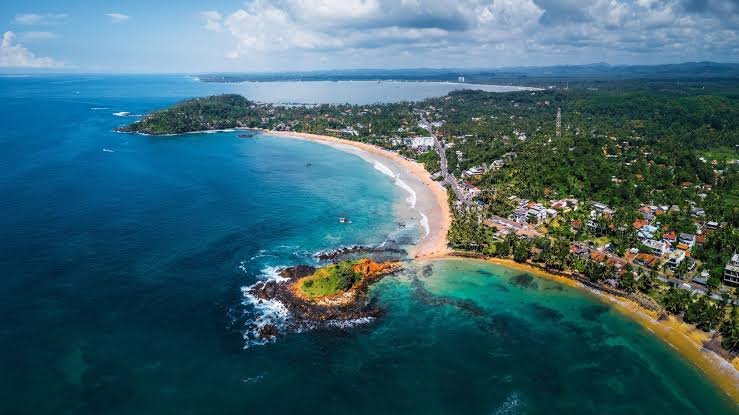
Sri Lanka’s tourism sector is currently facing a significant slowdown in growth for the second consecutive month, with the month of July 2025 presenting a marked deceleration in arrival numbers. The country, known for its lush landscapes, pristine beaches, and rich cultural heritage, has seen a sharp drop in momentum compared to the previous months of 2025. This change has raised concerns among industry stakeholders, with many now pinning their hopes on a recently expanded visa-free scheme to help reverse the trend and bring the country closer to its ambitious annual tourism target.
Slower Growth in July: A Year-on-Year Comparison
Between July 1st and 23rd, Sri Lanka welcomed a total of 145,188 tourists. This figure represents a modest 3.5% increase compared to the same period in July 2024, when 140,314 visitors arrived. While this growth may seem positive at first glance, it represents a considerable slowdown compared to the steady increases seen in previous months of 2025. In fact, growth rates in June (21.8%), May (18.5%), and April (17.3%) had been much higher, indicating that the tourism sector was experiencing a much stronger trajectory earlier in the year.
The decline in growth has raised concerns within the tourism industry, particularly as it occurred during the peak summer season. With the month of July being a prime period for international tourism, the relatively low increase in visitor numbers is a surprising turn of events. However, despite the slower pace, there is still hope that upcoming strategies, particularly the expanded visa-free scheme, will help boost numbers in the coming months.
India Remains the Top Source Market for Visitors
India has consistently been the largest source of tourists to Sri Lanka, and this trend continues in July 2025. Between the 1st and 23rd of July, 27,786 Indian tourists arrived, accounting for 19.1% of all visitors. This robust figure reflects the close ties between Sri Lanka and India, both geographically and culturally. The proximity of the two countries, along with strong cultural and historical links, has made Sri Lanka a prime destination for Indian travelers, and it continues to be a key market for Sri Lanka’s tourism sector.
Following India, the United Kingdom holds the second position, contributing 16,750 visitors, or 11.5% of the total arrivals. The Netherlands ranks third with 10,809 visitors, representing 7.4% of all travelers to Sri Lanka in this period. Other key source markets for Sri Lanka include China and France, which round out the top five countries contributing to the island’s tourism industry.
While the number of German visitors did see a decline in July, this year’s growth in British arrivals has somewhat offset this dip, further underscoring the importance of the UK market. Despite global challenges, these high-performing markets remain integral to Sri Lanka’s tourism sector.
Year-to-Date Performance: Positive Growth, Despite Recent Slowdown
Looking at the year-to-date performance, Sri Lanka’s tourism figures continue to show positive growth overall. From January 1st to July 23rd, 1,313,232 tourists visited the island, representing a 14.1% increase over the same period in 2024. This year-on-year growth reflects the continued global interest in Sri Lanka as a destination, despite the recent slowdown in arrivals during July.
As of mid-2025, India remains the dominant source market for the island’s tourism, with 269,780 Indian tourists arriving so far this year. The UK follows closely with 124,652 visitors, while Russia ranks third with 114,644 tourists. Other notable contributors to Sri Lanka’s tourism numbers include Germany and China, with 82,096 and 75,081 visitors, respectively.
While the first half of 2025 showed positive results, the slowdown in July raises the question of whether Sri Lanka can maintain this momentum in the remaining months. The country is now looking toward August through December to achieve its tourism goals for the year.
The Challenges Ahead: Meeting the 2025 Target
Sri Lanka has set an ambitious target of attracting 3 million tourists by the end of 2025. With 1.31 million arrivals recorded as of July 23rd, the country needs to bring in nearly 1.7 million more visitors in the remaining five months of the year. This will require a substantial increase in monthly arrivals, with the target set at approximately 340,000 tourists per month from August to December. Achieving this goal will not be easy, considering that the highest number of arrivals in a single month so far in 2025 was 252,761 in January, which was a record-breaking month.
The slow growth in July, despite being traditionally a peak month for tourism, has placed significant pressure on the tourism industry to make up for lost ground. To reach the 3 million mark, Sri Lanka’s tourism sector will need to see a substantial increase in visitors from its top source markets, as well as capitalize on any upcoming events or promotions that could attract tourists.
The Expanded Visa-Free Scheme: A Key Strategy for Reviving Growth
To counter the slowdown in growth and boost the country’s tourism sector, the Sri Lankan government has turned to its visa policy. The country has recently expanded its visa-free entry policy, which has been designed to facilitate easier travel for international visitors. The policy now includes 47 countries, up from a previous list of 7, which will significantly enhance Sri Lanka’s ability to attract tourists from key markets.
At the inauguration of the “Hotel Show Colombo 2025,” Sri Lanka’s Foreign Affairs, Foreign Employment, and Tourism Minister, Vijitha Herath, confirmed the Cabinet’s decision to waive visa fees for visitors from an additional 40 countries. The newly included countries represent some of Sri Lanka’s most important markets, including the United Kingdom, Germany, Netherlands, Australia, China, India, and the Russian Federation.
The hope is that the expansion of the visa-free scheme will help attract tourists from countries that have traditionally been strong markets for Sri Lanka. With the new policy in place, visitors from these 47 countries will find it easier and more convenient to travel to Sri Lanka, thereby boosting the number of arrivals in the months to come.
Minister Herath emphasized that the expansion of the visa-free scheme is a cornerstone of the government’s efforts to revive and strengthen the tourism sector. This decision is expected to contribute to the recovery of tourism by reducing administrative barriers, increasing accessibility, and ultimately driving more visitors to the island.
Tourism Growth: Opportunities and the Path Ahead
While Sri Lanka’s tourism industry is grappling with a slowdown, there is still plenty of potential for growth in the second half of 2025. The country has made significant strides in enhancing its tourism infrastructure, with ongoing efforts to improve the airport experience, expand hotel offerings, and attract more international events. By capitalizing on these efforts, Sri Lanka can encourage travelers to visit, experience its culture, and engage in its tourism activities.
The tourism sector also stands to benefit from continued diplomatic efforts and government initiatives that focus on both the traditional and emerging markets. For example, Sri Lanka’s focus on promoting its unique cultural heritage, stunning landscapes, and natural attractions will continue to appeal to travelers seeking both relaxation and adventure.
The expansion of visa-free access and the growth of global interest in Sri Lanka’s rich cultural experiences will likely lead to an uptick in arrivals, especially from countries that are newly included in the visa-free list. The increasing recognition of Sri Lanka as a safe, affordable, and enriching destination is likely to encourage more travelers to explore the island, particularly during the later months of 2025.
Looking Toward 2026: A More Resilient and Diverse Tourism Sector
Despite the challenges faced in 2025, Sri Lanka’s tourism sector remains resilient. The country’s long-term vision of attracting 3 million tourists in 2025 may have been difficult to achieve, but the efforts made in expanding the visa-free program, bolstering marketing initiatives, and focusing on quality tourism will continue to bear fruit in the years ahead. As 2025 progresses, Sri Lanka’s tourism sector will look toward new opportunities for growth and recovery, focusing on diversifying the types of tourists who visit the island.
The government’s ongoing initiatives to position Sri Lanka as a leading tourism destination in Asia will likely create new avenues for development. Whether it’s through bolstering its appeal as a wellness tourism hub, emphasizing its role as an adventure destination, or promoting its thriving culinary scene, Sri Lanka has the potential to grow as an international tourism powerhouse.
Conclusion: A Path to Recovery
Sri Lanka’s tourism sector has faced significant challenges in 2025, with the slowdown in arrival numbers during the summer months raising concerns. However, with the expanded visa-free scheme, which now covers 47 countries, and the ongoing efforts to enhance the country’s tourism infrastructure, there is hope for a revival in the second half of the year. Sri Lanka’s ability to adapt, innovate, and collaborate with international partners will ultimately determine the future trajectory of the country’s tourism industry.
While achieving the ambitious target of 3 million tourists in 2025 remains a tall order, the groundwork laid by the government and stakeholders in the tourism sector is positioning Sri Lanka for continued growth in the years ahead. As Sri Lanka continues to enhance its global appeal, the future of its tourism industry looks promising, with more travelers expected to experience the island’s unique charm and hospitality in the coming months and beyond.








